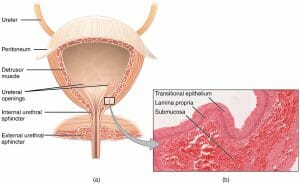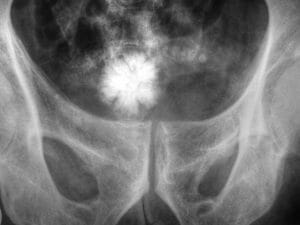Urinary Bladder Definition
The urinary bladder is an organ present in several animal species which stores urine, delivered by the kidneys through two ureters, prior to urination via the urethra. The human urinary bladder is hollow, muscular, and situated on the pelvic floor. The bladder is structurally composed of a broad fundus, body, apex, and a neck. There are three openings, each covered by a mucosal flab that prevents urine backflow into the ureters. The anatomical position of the bladder differs between men and women. In men, the urinary bladder resides in front of the rectum, whereas in women, it is positioned in front of the uterus. The bladder wall is extremely elastic, stretching from approximately 5 mm to less than 3 mm due to folds called rugae, which cover the inner walls. A diagram of the urinary bladder is presented below:
Urinary Bladder Function
The function of the urinary bladder is to collect and store urine from the kidneys until it can be excreted via urination. The typical human bladder can store an average of 300 mL to 500 mL of urine. As described above, the urinary bladder is highly elastic and is able to accommodate an increased volume of liquid due to the flattening of the rugae folds. Urination is not controlled by the bladder, but rather the pontine micturition center in the brain.
Diseases of the Urinary Bladder
There are several diseases of the urinary bladder. The typical symptoms of bladder diseases include frequent urination, pain, incomplete emptying, and irritation. Occasionally, diseases of other tissues or organs can affect the urinary bladder. For example, an enlarged prostate can cause frequent urination. The following are some of the most common pathologies of the urinary bladder:
Bladder Cancer
The most common type of bladder cancer is that derived from the epithelial lining of the bladder. This is exhibited by the fact that approximately 90% of all bladder cancer are carcinomas. The most likely cause of bladder cancer is thought to be medication, cigarette smoke exposure, and infections.
Urinary Tract Infection
Urinary tract infections are a common occurrence that can be severe and pose a major public health concern. Urinary tract infections are caused by bacterial infections in the bladder, usually caused by bacteria traveling up the urethra and into the bladder. Urinary tract infections are particularly dangerous when left untreated, as the infection can progress from the bladder into the kidneys. Common symptoms include a burning sensation during urination, cloudy and/or foul smelling urine, and the frequent urge to urinate, despite little urine being released.
Bladder Stones
Bladder stones are hard deposits composed of minerals found in the bladder caused by dehydration and highly concentrated urine residing in the bladder. Bladder stones can vary in size and are typically asymptomatic. Common symptoms are typically pain, blood in the urine, and irritation. X-rays (shown below), ultrasound, and CT scans are typically used to identify bladder stones.
Neurogenic Bladder
Neurogenic bladder is a type of brain disorder that impacts an individual’s ability to urinate. Since the peripheral nerves involved in urination are affected, urination is typically aided with a catheter. Patients often need to use intermittent catheterization several times a day to empty their bladder.
Bladder Exstrophy
Bladder exstrophy is a congenital abnormality which involves the protrusion of the bladder through the wall of the abdomen. This condition is extremely rare and is often accompanied by the abnormal development of the pelvic floor and other muscles, as well as the genitals, especially in women.
Bladder Sphincter Dyssynergia
Bladder sphincter dyssynergia refers to a condition in which the urethra sphincter cannot be relaxed in coordination with bladder contraction. Bladder sphincter dyssynergia is typically caused by a central nervous system injury or disorder. Patients frequently experience urine retention and a history of bladder infections.
Paruresis
Parauresis refers to a phobia involving the inability to urinate due to the presence or perceived presence of others. Parauresis is caused by a sympathetic nervous system response which tightens the sphincters in the bladder in response to adrenaline, thereby preventing urination. Parauresis typically requires psychological therapy as treatment.
Trigonitis
Trigonitis is a condition involving inflammation of the bladder. In particular, the trigone region of the bladder is a smooth triangular-shaped region and signals the need for urination in response to stretching. Although there are several causes of trigonitis, bladder infections are the most common etiology.
Interstitial Cystitis
Interstitial cystitis is a condition characterized by chronic bladder pain. While the specific cause of interstitial cystitis is unknown, patients exhibit damage to the epithelial lining of the bladder. Patients often experience the urge to urinate, frequent urination, and pain. Since the symptoms are highly similar to that of a urinary tract infection, a negative urine culture is typically used to establish a diagnosis.
Urinary Retention
Urinary retention is a condition in which an individual is unable to completely empty the bladder. Symptoms include poor pressure when urinating, the sensation of a full bladder, and straining to urinate. This condition is considered to be an emergency since the bladder could rupture if left untreated. Although there are a variety of causes, treatment often involves catheterization and in some cases, surgery may be required.
Quiz
1. The function of rugae is to:
A. Aid in stretching the bladder wall to accommodate urine.
B. Contract the bladder wall during urination.
C. Stimulate urination
D. Provide a site of attachment, connecting the bladder to the pelvic floor.
2. Frequent urination is a common symptom of:
A. Urinary tract infection
B. An enlarged prostate
C. Interstitial cystitis
D. All of the above
E. A and C only
References
- Feneley RC, Hopley IB, and Wells PN. (2015). Urinary catheters: history, current status, adverse events and research agenda. J Med Eng Technol. 39(8):459-70.
- Flores-Mireles A, Walker J, Caparon M, and Hultgren S. (2015). Urinary tract infections: epidemiology, mechanisms of infection and treatment options. Nature Reviews Microbiology. 13: 269–284.
- John BA and Said N. (2017). Insights from animal models of bladder cancer: recent advances, challenges, and opportunities. Oncotarget May 9. doi: 10.18632/oncotarget.17714.
- MacMullen NJ, Dulski LA, Martin PB, and Blobaum P. (2016). Nursing Care of Women With Interstitial Cystitis/Painful Bladder Syndrome. Nurs Womens Health. 20(2):168-80.
- Purves JT and Hughes FM Jr. (2016). Inflammasomes in the urinary tract: a disease-based review. Am J Physiol Renal Physiol.311(4):F653-F662.
- Taweel WA and Seyam R. (2015). Neurogenic bladder in spinal cord injury patients. Res Rep Urol. 7: 85-99.
Urinary Bladder
No comments:
Post a Comment